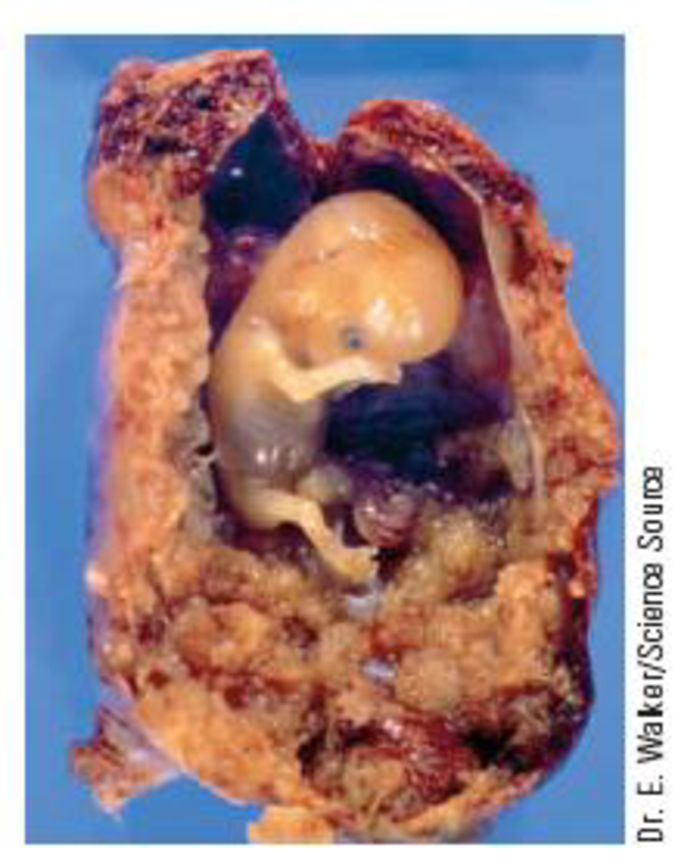
Human Biology (MindTap Course List)
11th Edition
ISBN: 9781305112100
Author: Cecie Starr, Beverly McMillan
Publisher: Cengage Learning
expand_more
expand_more
format_list_bulleted
Textbook Question
Chapter 17, Problem 4CT
The complications of ectopic pregnancy (Section 17.2) are life-threatening for the mother, and in fact each year in the United States a few pregnant women die when their situation is not diagnosed in time. Tragically, the only option is to surgically remove the embryo, which was doomed from the beginning. Based on what you know about where an embryo normally develops, explain why the ectopic embryo in Figure 17.25 could not have long survived.

Figure 17.25 This embryo, the result of an ectopic pregnancy, could not survive implantation outside its mother’s uterus.
Expert Solution & Answer
Want to see the full answer?
Check out a sample textbook solution
Students have asked these similar questions
In-vitro fertilization occurs in the laboratory. The resulting embryos remain in a laboratory culture for up to six days before being transferred to the potential mother. If fertilization had occurred naturally (i.e., inside the female reproductive system instead of in-vitro), where would the embryo be and what developmental processes would it be undergoing during those first six days of development?
Emily and her husband are thrilled as they peer into Emily's uterus by means of an ultrasound. The physician reports that the pregnancy appears normal and that their baby's organs, spine, and arms and legs are developing as expected. Given this information, the current stage of prenatal development is the
embryonic period germinal period zygotic period fetal stage placenta
A human is a complex organism that develops from a zygote. Briefly explain some of the the steps in this development process in the form of a paragraph. In your answer, be sure to: 1) explain how a zygote formed, 2) compare the genetic content of the zygote to the body cells of the parents, 3) identify the structure in which embryonic/fetal development usually occurs within, and 4) identify the structure that forms, which provides nourishment and waste removal to/from the developing baby.
Chapter 17 Solutions
Human Biology (MindTap Course List)
Ch. 17 - Define and describe the main features of the...Ch. 17 - Prob. 2RQCh. 17 - Summarize the development of an embryo and a...Ch. 17 - Label the early development stages shown in the...Ch. 17 - Prob. 1SQCh. 17 - During cleavage, the _______ is converted to a...Ch. 17 - Prob. 3SQCh. 17 - Prob. 4SQCh. 17 - _________ is the gene-guided process by which...Ch. 17 - In a human zygote, the cell divisions of cleavage...
Knowledge Booster
Learn more about
Need a deep-dive on the concept behind this application? Look no further. Learn more about this topic, biology and related others by exploring similar questions and additional content below.Similar questions
- What ethical issues are associated with the storage of embryos? Who should be making the decision about the status of stored embryos?arrow_forwardIn January 2009, Natalie Suleman successfully gave birth to octuplets and became known as Octomom. She already had 6 children, and all 14 of her children were conceived via in vitro fertilization (IVF). IVF involves removing eggs from the ovary, fertilizing them with sperm in a petri dish, and transferring the resulting embryos back into a uterus to develop. It is common for two or three embryos to be transferred into the uterus of a woman undergoing IVF to increase the chances of at least one of them surviving. When Ms. Suleman became pregnant with her octuplets, Dr. Kamrava had transferred 12 embryos. His license was revoked in 2011.Multiple eggs are required for IVF to produce functional embryos because some eggs are not fertilized or do not develop normally after fertilization. Which of the following hormones would be used to stimulate the ovaries to produce multiple eggs? Select one: a. Testosterone b. FSH c. Progesterone d. Estrogenarrow_forwardMaja Rotzky, a 19 y/o primigravid consultant, consulted on your clinic for her first prenatal check-up. The fundic height was measure to be at the level of umbilicus. Assuming that this is not multifetal pregnancy and there is no structural, or medical abnormality, approximately how many weeks AOG is this pregnancy? 18 weeks 20 weeks 12 weeks 24 weeks 16 weeksarrow_forward
- Some expensive home pregnancy tests claim to detect hCG as early as 5 days after conception ( when hCG are barely there). With the knowledge of how pregnancy tests work, please describe how a pregnancy test manufacturer could create such ultra sensitive test? Please be very briefarrow_forwardA friend in your dormitory, a freshman, tells you that she just discovered she is 3 months pregnant. You know that since she came to college she has been experimenting with recreational drugs. Circle the best advice you could give her, and explain your choice. (a) She must stop taking the drugs, but they could not have affected her fetus during these first few months of her pregnancy. (b) Harmful substances usually cannot pass from mother to embryo, so she can keep using drugs. (c) There could be defects in the fetus, so she should stop using drugs and visit a doctor as soon as possible. (d) If she has not taken any drugs in the last week, she is OK.arrow_forwardWhich of the following statement does NOT correctly describe the event of the following fertilization? Select one: A. As hCG takes over maintaining the endometrium immediately after implantation, the corpus luteum degenerates into the corpus albican. B. All 16 cells in a morula are truly totipotent, meaning that they can become any cells in the human body. C. The trophoblast has important in maintaining the pregnancy, as it prevents the endometrium from shedding. D. Only inner cells mass in a blastocyst is pluripotent.arrow_forward
- 10a) A female is exposed to a teratogen during the first and second month of pregnancy - before she even realizes she is pregnant. Which of the following birth defects might you expect to occur as a result? Defects of the eyes and ears Misformed or missing arms and/or legs Heart defects All of the above could possibly occur b) A female is exposed to a teratogen late in pregnancy, from the fourth month until birth. Which of the following birth defects might you expect to occur as a result? (Choose all that apply!) Heart defects Defects of the reproductive system Deformed or missing arms and/or legs Defects of the eyes and/or ears Learning disabilityarrow_forwardWhy do we consider a growing child to be alive, but not a growing crystal? Is abortion the taking of a human life? If so, what about a contraceptive foam that kills only sperm?arrow_forwardMrs . Vanessa Narciso, 29 year old G5P4 (4004) client who has had an uneventful healthy pregnancy is admitted to the hospital. The admitting doctor informs her that she is in the active phase of labor. The record also shows that the full-term baby is in the left occiput posterior position. Nurse Marina correctly says that the following are signs indicating that the labor is progressing, EXCEPT one: The intensity of uterine contraction becomes strong and board like inconsistency The duration becomes longer-lasting for 10 to 20 minutes The frequency is every 2 to 3 minutes The interval becomes shorterarrow_forward
- Some expensive home pregnancy tests claim to detect hCG as early as 5 days after conception ( when hCG are barely there). With the knowledge of how pregnancy tests work, please describe how a pregnancy test manufacturer could create such ultra sensitive test?arrow_forwardQuestion:- There are specific critical periods during fetal development in which any damage caused to the fetus from malnutrition or exposure to toxins is irreversible. When do these periods occur? a) 3rd trimester b) 1st trimester c) 2nd trimester d) only at week 12 e) there are no critical periodsarrow_forwardRetinoic acid is the main component of Tretinoin, an anti-cancer chemotherapy drug. Retinoic acid is also a known teratogen which can cause congenital anomalies in eyes, ears, hearts, lungs, limbs, and many other organ systems. Based on the organ systems that are impacted by exposure to retinoic acid, during which of the following trimesters of pregnancy are developing humans most susceptible to the teratogenic effects of retinoic acid? aFirst trimester b.Second trimester c.Third trimesterarrow_forward
arrow_back_ios
SEE MORE QUESTIONS
arrow_forward_ios
Recommended textbooks for you
 Human Biology (MindTap Course List)BiologyISBN:9781305112100Author:Cecie Starr, Beverly McMillanPublisher:Cengage Learning
Human Biology (MindTap Course List)BiologyISBN:9781305112100Author:Cecie Starr, Beverly McMillanPublisher:Cengage Learning

Human Biology (MindTap Course List)
Biology
ISBN:9781305112100
Author:Cecie Starr, Beverly McMillan
Publisher:Cengage Learning
Reproduction: Crash Course Zoology #9; Author: CrashCourse;https://www.youtube.com/watch?v=poLyJDVjKlM;License: Standard youtube license